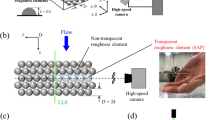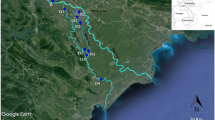Abstract
The sedimentation of cohesive particles has negative effects on water resource management such as siltation of dams as well as reducing water quality. Sedimentation processes are governed mainly by the flocculation and the settling of suspended particles, which are affected by many factors simultaneously. To provide a reliable solution to this problem, the contribution of the different factors to the sedimentation mechanism must be analysed. The majority of research considers only one single factor. In this experimental study, the combined effect of two significant parameters is considered: the salinity of the solution and the initial concentration of suspended solid matter. Experiments were conducted on mixtures with different sediment concentration (100, 150 and 200 g/l) under different salinity conditions. The chemical additives used for the preparation of sedimentary solutions are sodium chloride (NaCl), sodium hydroxide (NaOH), sulphuric acid (H2SO4), ferrous sulphate (FeSO4) and potassium permanganate (KMnO4). Attention has been given to the evolution of hydrodynamic parameters such as settlement height, settling velocity and the permeability coefficient. The results show that settlement over time increases with increasing initial sediment content, and the height of deposited layers in salt water is lower than that in fresh water for the same sediment concentration. Settlement height increases with increasing salt concentration. Settling velocity and the permeability coefficient decrease with increasing initial sediment content. The variations of these two parameters are much more pronounced from 100 to 150 g/l of sediment concentration than for 150–200 g/l, particularly for mixtures with high chemical concentration. The influence of salinity on sedimentation processes depends on the initial concentration of suspended solid matter, on the chemical concentration and notably on the chemical composition of the solution (the effect of salinities is much more important for mixtures with NaCl and H2SO4 solutions).


















Similar content being viewed by others
References
Abdollahi S, Madadi M, Ostad-Ali-Askari K (2021) Monitoring and investigating dust phenomenon on using remote sensing science geographical information system and statistical methods. Appl Water Sci 11(7):1–14. https://doi.org/10.1007/s13201-021-01419-z
Been K (1980) Stress strain behaviour of a cohesive soil deposited under water. Dissertation, Oxford University
Cao DF, Shen YM, Su MR, Yu CX (2019) Numerical simulation on hydrodynamic environment effects of the reclamation project of Nanhui tidal flat Yangtze Estuary. J Hydrodyn 31(3):603–613. https://doi.org/10.1007/s42241-019-0006-4
Chandra V, Mohapatra PK, Nestmann F (2012) Effect of flow depth, ions, and salinity on suspended sediment. J Hydraul Eng 138(4):348–352
Chemsa A (2006) Valorisation of dredged sediments: Applications in the construction industry, case of the Fergoug dam. Dissertation, University of Reims
Diaz JMF, Sato CR, Suarez JEB, Plata MAB, Gonzalez JMF, Velasco EC (2021) A method for economic estimation of dam siltation: a case study in Mexico. Model Earth Syst Environ. https://doi.org/10.1007/s40808-021-01264-8
Forsberg PL, Skinnebach KH, Becker M, Ernstsen VB, Kroon A, Andersen TJ (2018) The influence of aggregation on cohesive sediment erosion and settling. Cont Shelf Res 171:52–62. https://doi.org/10.1016/j.csr.2018.10.005
François B, Corda G (2022) Experimental characterization and numerical modelling of the self-weight consolidation of a dredged mud. Geomech Energy Environ 29:100274. https://doi.org/10.1016/j.gete.2021.100274 (article in press)
Kynch GJ (1952) A theory of sedimentation. Soc Faraday Trans 48:166–176
Li ZY, Zhang JF, Zhang QH, Shen XT, Chen TQ (2021) Effects of organic matter and salinity on the flocculation of kaolinites in a settling column. J Hydrodyn 33(1):150–156. https://doi.org/10.1007/s42241-021-0017-9
Manning AJ, Schoellhamer DH (2013) Factors controlling floc settling velocity along a longitudinal estuarine transect. Mar Geol 345:266–280. https://doi.org/10.1016/j.margeo.2013.06.018
Mekerta B, Semcha A, Rahmani F, Troalen JP (2008) Erosion spécifique et caractérisation de la résistance au cisaillement des sédiments du barrage de Fergoug. Xèmes Journées Nationales Génie Côtier—Génie Civil, 14–16 octobre 2008, Sophia Antipolis
Migniot C (1989) Tassement et rhéologie des vases. Houille Blanche 2:95–111
Moghbeli A, Khanjani MJ, Kermani MZ (2021) An experimental study of the geometric performance of hydrosuction dredging system. Acta Geophys 69:271–283. https://doi.org/10.1007/s11600-020-00524-y
Nafchi RF, Bouroujeni HS, Vanani HR, Ostad-Ali-Askari K, Brojeni MK (2021) Laboratory investigation on erosion threshold shear stresses of cohesive sediment in Kharkheh Dam. Environ Earth Sci 80:681. https://doi.org/10.1007/s12665-021-09984-x
Orton PM, Kineke GC (2001) Comparing calculated and observed vertical suspended-sediment distributions from a Hudson river estuary turbidity maximum. Estuaf Coast Shelf Sci 52(3):401–410. https://doi.org/10.1006/ecss.2000.0747
Ostad-Ali-Askari K, Kharazi HG, Shayannejad M, Javad M (2020) Effect of climate change on precipitation patterns in an arid region using GCM models: case study of Isfahan-Borkhar Plain. Nat Hazards Rev. https://doi.org/10.1061/(ASCE)NH.1527-6996.0000367
Partheniades E (2009) Cohesive sediments in open channels, 1st edn. Elsevier Inc., Burlington
Pejrup M, Mikkelsen OA (2010) Factors controlling the field settling velocity of cohesive sediment in estuaries. Estuaf Coast Shelf Sci 87(2):177–185. https://doi.org/10.1016/j.ecss.2009.09.028
Portela LI, Ramos S, Teixeira AT (2013) Effect of salinity on the settling velocity of fine sediments of a harbour basin. J Coast Res 65(S.I):1188–1193. https://doi.org/10.2112/SI65-201.1
Remini B (2017) A new management approach of dams siltation. Larhyss J 31:51–81
Remini B (2019) Algeria: the mud at the bottom of the dams, what to do. Larhyss J 40:213–247
Sanchez M (2000) Dynamique des sédiments fins en milieu marin et agitation portuaire. HDR, University of Caen, Caen
Sanchez M, Grovel A (1994) Settlement: a sedimentary process. In: Belorgey M, Rajaona RD, Sleath JFA (eds) Euromech 310 Sediment transport mechanisms in coastal environments and rivers. World Scientific, Singapore, pp 146–151
Sanchez M, Grimigni P, Delanoë Y (2005) Steady-state vertical distribution of the cohesive sediments in a flow. Comptes Rendus Geosci 337(3):357–365. https://doi.org/10.1016/j.crte.2004.10.020
Sanchez M (1992) Modélisation dans un estuaire à marée—Rôle du bouchon vaseux dans la tenue des sols sous-marins. Dissertation, University of Nante
Shao Y, Maa JPY (2017) Comparisons of different instruments for measuring suspended cohesive sediment concentrations. Water 9:968. https://doi.org/10.3390/w9120968
Soulsby RL, Manning AJ, Spearman JR, Whitehouse RJS (2013) Settling velocity and mass settling flux of flocculated estuarine sediments. Mar Geol 339:1–12. https://doi.org/10.1016/j.margeo.2013.04.006
Spearman JR, Manning AJ, Whitehouse RJS (2011) The settling dynamics of flocculating mud and sand mixtures: part 2: numerical modeling. Ocean Dyn 61(2–3):351–370. https://doi.org/10.1007/s10236-011-0385-8
Sun H, Li D, Xu L, Shi L, Pan X, Geng X, Cai Y (2019) Modeling the process of cohesive sediment settling and flocculation based on CFD-DEM approach. Granul Matter 21:33. https://doi.org/10.1007/s10035-019-0882-x
Tan TS, Yong KY, Leong EC, Lee SL (1990) Sedimentation of clayey slurry. J Geotech Eng 116(6):885–898
Tattersall GR, Elliott AJ, Lynn NM (2003) Suspended sediment concentrations in the Tamar estuary. Estua Coast Shelf Sci 57(4):679–688. https://doi.org/10.1016/S0272-7714(02)00408-0
Thill A, Moustier S, Garnier JM, Estournel C, Naudin JJ, Bottero JY (2001) Evolution of particle size and concentration in the Rhône river mixing zone: influence of salt flocculation. Cont Shelf Res 21(18–19):2127–2140. https://doi.org/10.1016/S0278-4343(01)00047-4
Thorn MFC (1981) Physical processes of siltation in tidal channels. Hyd Model Appl Mar Eng. https://doi.org/10.1680/hmime.01541.0009
Verney R, Lafite R, Brun-Cottan JC (2009) Flocculation potential of estuarine particles: the importance of environmental factors and of the spatial and seasonal variability of suspended particulate matter. Estuar Coasts 32(4):678–693. https://doi.org/10.1007/s12237-009-9160-1
Wett B (2002) A straight interpretation of the solids flux theory for a three-layer sedimentation model. Water Res 36(12):2949–2958. https://doi.org/10.1016/s0043-1354(01)00523-1
Winkler MKH, Bassin JP, Kleerebezem R, Van Dar LRGJM, Van Loosdrecht MCM (2012) Temperature and salt effects on settling velocity in granular sludge technology. Water Res 46(16):3897–3902. https://doi.org/10.1016/j.watres.2012.07.022
Ye L, Manning AJ, Hsu TJ (2020) Oil–mineral flocculation and settling velocity in saline water. Water Res 173:115569. https://doi.org/10.1016/j.watres.2020.115569
Author information
Authors and Affiliations
Corresponding author
Ethics declarations
Conflict of interest
On behalf of all authors, the corresponding author states that there is no conflict of interest.
Additional information
Responsible Editor: Mohamed Ksibi.
Rights and permissions
Springer Nature or its licensor holds exclusive rights to this article under a publishing agreement with the author(s) or other rightsholder(s); author self-archiving of the accepted manuscript version of this article is solely governed by the terms of such publishing agreement and applicable law.
About this article
Cite this article
Menad, K., Nougar, B., Brahimi, A. et al. Experimental hydrodynamic study of mud sedimentation processes. Euro-Mediterr J Environ Integr 7, 433–444 (2022). https://doi.org/10.1007/s41207-022-00316-4
Received:
Accepted:
Published:
Issue Date:
DOI: https://doi.org/10.1007/s41207-022-00316-4




